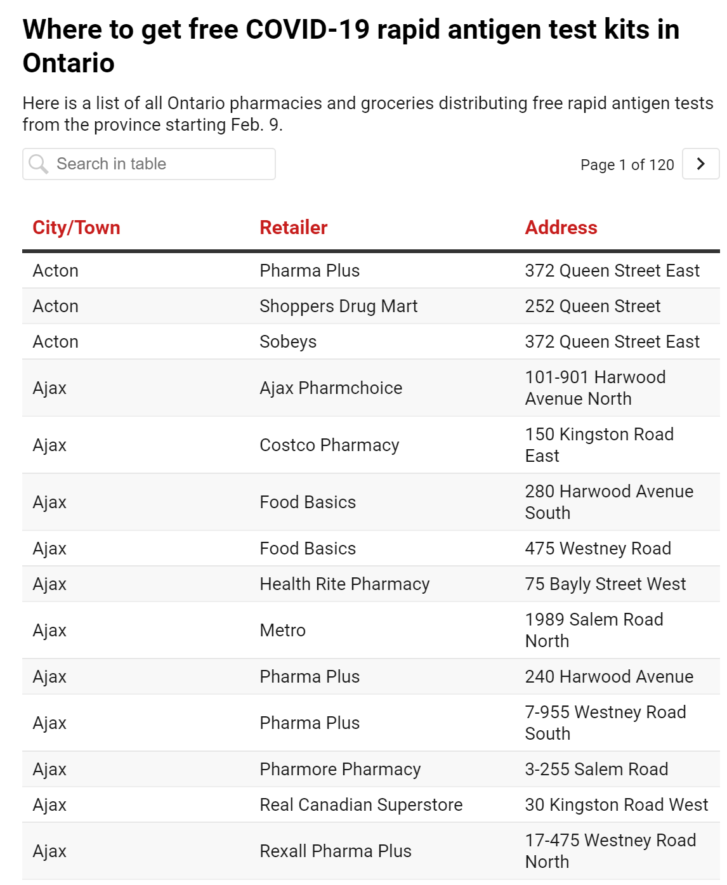Starting today, Feb. 9, a select number of Ontario pharmacies and grocery stores are distributing COVID-19 rapid antigen tests.
The Ontario government said 5.5 million tests will be distributed each week at more than 2,300 retailers across the province. Some stores will offer take-home testing kits for in-store pickup, while others will provide tests through an online ordering system.
You can search the table below to find where you can get the free RATs.
If you are viewing this story on CTV News mobile app, click here for the full list.

Ontario residents can now pick up a free box of rapid COVID-19 tests at select grocery stores and pharmacies across the province.
As reported by CTV News Toronto on Tuesday, the Ontario government will make about 5.5 million tests available each week and distribution will be limited to one box (5 tests) per household per visit.
At least 2,406 sites are participating, including 2,385 pharmacy and grocery locations and 21 “high priority community lead agencies” for 17 vulnerable neighbourhoods.
The tests at grocery stores and pharmacies will be made available as of Feb. 9 through online order or in-store pickup.
“These tests will provide another layer of protection, support the provinces efforts to cautiously and gradually ease public health measures, and offer people an additional tool that they can use to confidently do the things they love, like visiting family or dining out at their favorite local restaurant,” Health Minister Christine Elliott said at a news conference in Kitchener, Ont. Wednesday.
The initiative announced by the province on Wednesday builds upon the previously announced strategy of earmarking rapid tests for priority sectors, including hospitals and long-term care homes as well as education and child-care settings. Those areas currently receive 10.3 million rapid tests per week, according to the government.
Ontario’s COVID-19 testing strategy shifted in late December as an Omicron-fuelled wave of COVID-19 infections swept the province. Since then, polymerase chain reaction (PCR) tests are only available to symptomatic high-risk individuals and those who work in the highest risk settings, as well as vulnerable populations and public schools.
At the same time, demand for rapid tests soared as Ontarians tried to get their hands on a kit and the province provided 2 million tests to the public through its holiday pop-up blitz.
Retailers participating in the program include Shoppers Drug Mart, Loblaws, Metro, Rexall, Sobey’s, Longo’s, and Walmart. It should be noted that at Walmart, customers must spend a minimum of $35, before taxes, to obtain a test.
A full list of locations where the rapid test kits are available can be found here.
The program is expected to last eight weeks and will see up to 44 million tests distributed in total. The government could not say whether or not the program would be extended beyond that point.
There are no measures in place to prevent an individual from travelling to multiple locations and picking up multiple boxes of tests. Instead, the province is asking residents to be responsible and avoid hoarding.
The provincial government said it has procured a total of 157.6 million rapid tests since the beginning of the COVID-19 pandemic. Of those tests, 80.48 million have been received by Ontario and 75.98 million have been deployed.
According to the Ministry of Health, 99 per cent of all deployed tests have been used.
WHEN SHOULD YOU USE A RAPID COVID-19 TEST?
As access to rapid COVID-19 testing expands, the government is reminding the public about the best practices for using the tool as the province continues to relax its public health guidelines.
For people with symptoms:
- The government says that a positive rapid antigen test is “highly indicative” that a symptomatic individual has COVID-19 and the individual and their households are required to self-isolate following the province’s updated guidelines on quarantining.
- If two consecutive rapid tests separated by 24 to 48 hours are both negative, a symptomatic individual is less likely to be infected and is advised to self-isolate until symptoms are improving for 24 hours or 48 hours if the symptoms are gastrointestinal.
For people without symptoms as screening:
- “One-off testing,” as described by the Ministry of Health, before a social gathering by people who are asymptomatic and without known exposure to someone with COVID-19, is generally not recommended.
- If you choose to use your rapid test in this way, it should be completed as close to the event as possible while acknowledging that a negative result could be a false negative.
For test-to-work purposes:
- The “test-to-work” strategy should be used to support “work-self” isolation in critical work shortages in the highest risk settings only and where staff are able to return to work following a series of negative tests instead of self-isolating at home.
Also, a positive rapid antigen test does not require a confirmatory PCR or rapid molecular test or reporting to public health.
Article From: CTV news
Author: Phil Tsekouras

